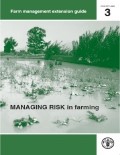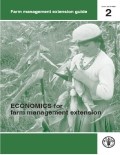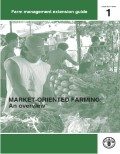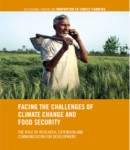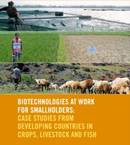Publications
This guide is intended to help extension workers better understand the concept of risk, the situations where risk occurs and management strategies that can be used to reduce, or at least soften its effect. It is hoped that the guide will be useful in assisting extension workers to provide farmers with advice on the kind of risk management strategies that they can employ to deal with risk in their day-to-day farming operations.
This guide has been prepared for agricultural extension workers to introduce them to some of the principles of economics that are relevant to smallholder farming and in particular market-oriented farming. The reader will gain a basic understanding of some of the terms and concepts used in economics and relate them to the day-to-day decisions that farmers make. The aim of this guide is to build skills that will enable extension workers to assist farmers make the kinds of farm management decisions that lead to greater farm profitability.
This series was developed to help extension workers provide support to farmers in dealing with the new challenges that arise from market-oriented farming. The aim is to contribute to building their capacity and skills in farm management and through them, the capacity and skills of the farmers with whom they work. The intention is to help farmers understand why they make the choices they make and how they can improve their decision making skills.
In 2010, a study was carried out to assist the Research and Extension Branch in FAO to position itself strategically in meeting needs and demands that arise as a consequence of climate change. The goal of the study was also to assist other global and national agencies meet these needs. The results of the study formed the basis for the report “Facing the challenges of climate change and food security: the role of research, extension and communication institutions”.
This book documents a unique series of 19 case studies where agricultural biotechnologies were used to serve the needs of smallholders in developing countries. They cover different regions, production systems, species and underlying socio-economic conditions in the crop (seven case studies), livestock (seven) and aquaculture/fisheries (five) sectors.
The biotechnologies covered include some that are considered quite traditional, such as fermentation and artificial insemination, as well as other more modern ones, such as the use of DNA-based approaches to detect pathogens.
Occasional papers on Innovation in Family Farming

